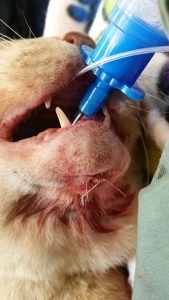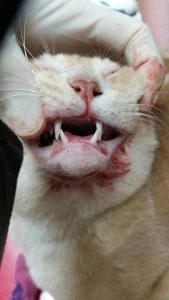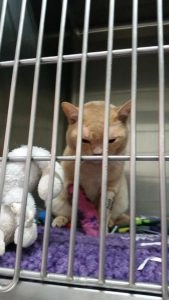Casey – an 18 month old Burmese Cat with a Dog Bite
Poor 18 month old Casey arrived at our clinic one Friday afternoon – he’d escaped from his home and been bitten on the head by a dog. He had very obvious bruising around the top of his head, as well as some generalised inflammation to his head and face. Our examination revealed a separated symphysis of his lower jaw (a common injury when a rotational force is applied to the head and jaw). X-rays revealed that his head, jaw and facial structures hadn’t sustained any other damage. His breathing was even and didn’t appear to have suffered any chest or abdominal injuries either.
Casey was placed on IV fluids and was given long-acting antibiotics, NSAID (an anti-inflammatory injection), buprenorphine (an opioid injection) and a fentanyl (opioid) patch was applied to his foreleg. He spent the night in hospital for monitoring.
Come the next morning, Casey appeared much brighter and happier. He was anaesthetised with O2/isoflurane via mask, intubated and then placed onto O2/isoflurane gas maintenance.
We placed 20-inch needles through the skin on either side of his lower canines, which acted as a guide for the wires.
We then placed wire around Casey’s teeth to hold the lower jaw symphysis together and allow it to heal. After removing the needle guides, the wire was tied underneath his jaw. Whilst the wire is usually left outside the skin, we prefer to bury it underneath the skin during the healing period instead (to ensure that the wire doesn’t catch on bedding or other material). After 6 to 8 weeks, the wire is removed.


